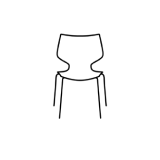
Blog
Your go-to destination for design inspiration and practical tips to transform your home. Discover the latest interior trends, style hacks, and budget-friendly ideas to create a space you'll love.
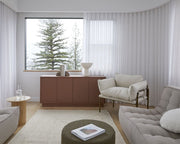
The Art of Accessorising: Top Tips for Decorating Your Sideboard
Your sideboard is more than just a practical storage solution; it's an opportunity to showcase your style and elevate the aesthetic of your space. Whether it's in the dining room, living area, or hallway, here are top tips for mastering the art of accessorising your sideboard.Start with a Focal Point Begin by selecting a focal point for your sideboard. This could be a large mirror to enhance the beauty of natural light and give the illusion of a larger space, a piece of artwork, or a decorative wall hanging to compliment your aesthetic and style. This sets the tone for the rest of your accessories and draws attention to the sideboard as a stylish centrepiece.Layered Lighting Add depth and ambiance with layered lighting. Place a set of table lamps on each end of the sideboard to create symmetry, or place one statement lamp on one side to allow for more space for smaller decor. Setting a cosy mood for night-time and illuminating the space to create a warm and inviting atmosphere. Balance and Symmetry Achieve a sense of balance by arranging accessories symmetrically. If you have a large statement piece on one side, balance it with smaller items or a grouping of accessories in descending size order. Symmetry creates visual harmony and a polished look.Greenery and Florals Introduce a touch of nature with potted plants, succulents, or a vase of fresh flowers. Greenery not only brings life to your sideboard but also adds a refreshing and vibrant element to the decor.Add a Personal Touch Infuse your personality into the display by incorporating collectibles or items with sentimental value. Whether it's antique trinkets, travel souvenirs, or your favourite family photo, these personal touches tell a story and make your sideboard uniquely yours. Mix Textures and Heights Create visual interest by incorporating a combination of textures and varying heights. Combine smooth ceramics, textured vases, and metallic elements to add diversity. This dynamic arrangement adds depth and captures attention. Candles for Ambience Enhance the atmosphere with the soft glow of candles. Candle holders or decorative candles can add a touch of sophistication and create a cosy ambiance, making your sideboard a focal point in the evening.Themed Displays Your sideboard provides you with the perfect place to style themed displays for special occasions or seasons. Switching out accessories based on holidays or seasons keeps your decor fresh and dynamic, allowing your sideboard to reflect the changing atmosphere of your home.Negative Space Don't overcrowd your sideboard. Embrace some negative space to allow the eye to rest. This minimalist approach adds a contemporary touch and prevents the display from feeling cluttered. Decorating your sideboard is an art that involves a thoughtful curation of elements. By incorporating focal points, layered lighting, greenery, and a mix of textures, you can transform your sideboard into a stylish expression of your personality. Experiment with different arrangements, and don't be afraid to showcase your creativity. The art of accessorising your sideboard is a journey of self-expression and design exploration.
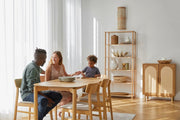
Pull Up a Chair: Selecting the Perfect Dining Chairs for Your Home
Your dining area is a place for gathering, sharing meals, and creating memories. The right dining chairs can enhance your dining experience, whether you have a formal dining room, a cosy kitchen nook, or a multifunctional space. Choosing the ideal dining chair involves considering factors like size, materials, comfort, style, and your specific lifestyle and space requirements. Here's a comprehensive guide to help you pick the perfect chairs for your dining area.Size:The size of your dining chairs should complement the size of your dining table and the room itself. Here are some key considerations: Proportion: If your dining room is small, opt for chairs that are not too chunky or wide, as they can overwhelm the space. Slender and streamlined chairs work well in tight quarters. For spacious rooms, you have more flexibility in choosing bulkier chairs.Spacing: Make sure there's enough space around each chair for comfortable seating and movement. Leave approximately 15-25 centimetres of space between each chair, especially if you have armchairs. Measure your dining area to determine how many chairs it can accommodate comfortably.Tip: Your choice of dining chairs should complement the dining table. For larger dining rooms, where space is not a constraint, you can consider a six-seater or even a larger table, providing ample room for more substantial,chairs.Materials:The choice of materials for your dining chairs is not just about aesthetics but also practicality: Wood: Wooden dining chairs are classic and versatile. They suit a variety of dining table styles and can be easily refinished if they show signs of wear. Solid wood chairs are sturdy and durable.Upholstery: Fabric or leather-upholstered chairs add a touch of luxury and comfort to your dining area. However, they may require more maintenance, particularly if you have children or pets. Look for stain-resistant fabrics for easy clean-up.Metal: Metal dining chairs, such as steel or aluminium, offer a modern and industrial look. They're lightweight and easy to clean, making them ideal for busy households.Plastic or Acrylic: Plastic chairs are affordable, easy to clean, and available in various colours and designs. They're perfect for outdoor dining areas as well.Comfort:Comfort should be a priority, especially if you anticipate long dinner parties or have family members who enjoy leisurely meals. Here's what to consider:Seat Depth and Height: Ensure that the seat depth and height are comfortable for extended sitting. A seat that's too deep or too high can lead to discomfort.Cushioning: If you prefer upholstered chairs, look for models with ample cushioning. Dense foam padding can provide extra comfort during long meals.Backrest: A supportive backrest with the right contour can enhance comfort. Chairs with an ergonomic design help promote good posture.Lifestyle and Use: Your lifestyle and how you use your dining area will also influence your chair choice: Family-Friendly: If you have young children, consider chairs that are easy to clean, as spills are inevitable. Stain-resistant fabrics or wipeable materials like plastic or leatherette can be a good choice.Hosts and Entertainers: If you often host dinner parties or family gatherings, prioritise comfort, and consider chairs with plush cushioning. Upholstered chairs can make guests feel more comfortable and encourage them to linger at the table.Versatile Lifestyle: For those with a dynamic lifestyle, versatility is key when selecting dining chairs. Timber-framed chairs with comfortable upholstery, for both the seat and backrest, offer a timeless and adaptable solution. These chairs transition from ahosting companion to working from home. They provide comfort during meals and are perfect for occasional seating needs. Style and Aesthetics:Finally, the style and aesthetics of your dining chairs should harmonise with your overall decor:Matching or Mixing: You can choose chairs that match your dining table and buffet for a coordinated look. Alternatively, mix-and-match different styles for an eclectic and trendy appearance.Colour and Finish: Consider the colour or finish of the chairs. A cohesive colour scheme or contrasting tones can create a visually pleasing dining area.Chair Design: The design of your chairs, whether contemporary, classic, or somewhere in between, should complement your decor. Dining chairs are a great way to showcase your personal style.Selecting the right dining chairs is a combination of aesthetics, comfort, and practicality. By considering your room's size, materials, comfort, lifestyle, and style preferences, you can choose chairs that not only look great but also enhance your dining experience. With these considerations in mind, you're on your way to creating a dining area that you and your guests will love.
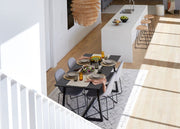
Dine in Style: Tips for Choosing the Best Dining Table
The dining table is the heart of the home, where family and friends gather to share meals and make lasting memories. Choosing the right dining table is an important decision, as it sets the tone for your dining space and can influence the overall aesthetic of your home. In this guide, we'll share various factors to consider when selecting the perfect dining table that suits your style, space, and needs. Determine your Dining Area Embarking on your journey to select the ideal dining table begins with this number 1 step: measuring your dining area. This initial assessment serves as the foundation for determining the most suitable size and shape to harmonise with your space and requirements. Knowing the exact dimensions of your space is key to avoid purchasing a table that's either too small or too large. Be sure to leave enough space for chairs to be pushed back comfortably, allowing for easy movement around the table. Consider both the width and length of your dining area. Tip: When measuring your dining area, if you're uncertain about the ideal table size, a helpful tip is to use painter's tape or masking tape to mark out the potential table sizes you're considering directly on your floor. This visual aid allows you to better visualize how each size would fit within the space, ensuring there's sufficient room around the table, especially when considering the placement of dining chairs. Choosing the Right Shape Ensure you're choosing the right shape for your dining table as it affects both the aesthetics and functionality of your dining area. Rectangular Tables: These are the most common and versatile dining table shapes. They offer plenty of space and work well in long, narrow rooms. However, their linear design may not be the best fit for smaller spaces. Round Tables: Round tables encourage intimate conversations and are great for smaller areas. They also eliminate the issue of sharp corners, making them safer for homes with children. Square Tables: Square tables are a chic choice for both small and larger spaces. Their symmetrical design is visually appealing and provides a sense of balance in the room. Oval Tables: Combining the qualities of rectangular and round tables, oval tables are versatile and ideal for accommodating extra guests. Their rounded edges soften the room's aesthetic. Consider your room's layout and how you envision using your dining area to determine which shape tablewill work best for you. Remember that the shape not only affects the table's visual impact but also how guests interact during meals and gatherings.Decide on Material Dining tables come in various materials, each with its unique aesthetic and maintenance requirements: Timber-Look: Timber-look dining tables emulate the charm of wood without the maintenance. Crafted from materials like MDF or particleboard and covered with wood-grain laminate or veneer, these tables offer various finishes and can mimic different wood types. Ideal for those seeking a warm, wood-like appearance with less upkeep. Metal: Metal dining tables infuse a modern, industrial flair into your dining area. Typically made of steel or aluminium, these tables are durable and sport a contemporary look with clean lines. Their lightweight nature makes them easily movable, suitable for those who prefer urban, minimalist aesthetics. Plastic: Plastic dining tables are versatile, lightweight, and easy to clean. Theyare great for those who are looking for an affordable alternative and households with children, providing a durable and spill-resistant surface. Glass: Glass dining tables offer a touch of elegance and sophistication. They come in various shapes and sizes and often feature a glass tabletop paired with metal or wooden legs. Glass tables can give the illusion of a larger space due to its transparency and ability to reflect natural light. Concrete: Concrete dining tables bring an element of industrial chic to your dining area but tend to be more expensive than other materials. They are durable and often mixed with other materials like wood or metal to add warmth and style.They are particularly suitable for outdoor spaces and contemporary, urban interiors. By considering the material, you can select a dining table that aligns with your personal style, practical needs, budget, and the ambiance you want to create in your dining space.Consider Your Lifestyle, Style, and Seating To select the perfect dining table, consider your lifestyle, style preferences, and seating needs. Your daily routine matters - busy family households may opt for durable, easy-to-clean materials like plastic or metal, while those who love hosting might lean toward stylish, comfortable options like timber-look, glass, or marble tables. Style preferences play a pivotal role. Match your table to your interior design - metal or glass for modern, industrial, or minimalist spaces, and for more versatile spaces, timber-look,or concrete for various aesthetics. For a playful touch, consider plastic tables in casual or outdoor settings. Don't forget to think about your usual seating arrangements. Flexible setups benefit from extendable tables, while intimate dining for two suits round or square tables. Larger gatherings thrive with rectangular or oval options. By considering these aspects, you'll make a choice that harmonises both with your daily life and your dining area's look and feel. Choosing the right dining table is not just about functionality; it's about enhancing the beauty and comfort of your dining space. By considering factors such as space, shape, material, lifestyle, style, budget, and seating, you can make an informed decision and select a dining table that suits your needs and allows you to dine in style. Remember that your dining table is more than just a piece of furniture; it's where cherished moments are shared, and lasting memories are created.

Dining Tables for Small Spaces: Maximising Your Dining Area
Small living spaces, whether it's an apartment, cosy condo, or petite home, often present challenges when it comes to setting up a functional dining area. However, limited square footage doesn't mean you have to sacrifice style or the joy of sharing meals. With some creative solutions and space-saving ideas, you can maximise your dining area and make it a welcoming space for both everyday dining and entertaining. In this blog, we'll explore how to choose the perfect dining table for small spaces.Measure the Space Before you begin your search for the ideal dining table, take out the tape measure and size up your dining area. Precision is key. Note the dimensions of the space, especially its width and length. Consider the layout of the room and the available space when chairs are pulled out. By knowing these measurements you'll understand the maximum size of a table that will complement the area and not overwhelm it. This ensures that you choose a table that fits comfortably and leaves enough room for movement.Round is the Way to Go In small spaces, round tables often work wonders. Their absence of corners means they fit seamlessly into tight corners and are more conducive to fluid movement around the dining area. Additionally, everyone seated at a round table is equidistant from the centre, creating an intimate atmosphere. Choose a round table that provides sufficient dining surface area for your everyday needs but doesn't overwhelm the space. The design should allow for comfortable seating while offering practicality. Choose Light Search for dining tables crafted from light materials, such as light-coloured woods or sleek whites. These materials give the illusion of a more open and airy space, making your dining area seem more spacious than it is. Light wooden textures or a clean, white finish can provide a fresh and contemporary feel to your small dining space, creating a visually expansive atmosphere.Keep it Simple and Streamlined When selecting a dining table for a small space, opt for simple, streamlined designs. Tables with minimal ornamentation and sleek lines create a contemporary and uncluttered look. This design approach makes your dining area feel less cramped. Space-Saving Seating To maximise your small dining area, pair your space-saving table with chairs or seating options that can be neatly tucked underneath when not in use. Consider benches, stackable chairs, or stools that can be stored efficiently. Open Shelving or Wall Storage Finally, consider incorporating open shelving or wall storage near your dining area. This provides extra storage space for dishes, glassware, or decor while keeping your dining area clutter-free. Considering measurements, shape, material, and functionality, will help you in choosing the perfect dining table for a small space. With the right table, you can create a cosy yet stylish dining area where you can enjoy meals, entertain guests, and make the most of your limited space. With these space-saving ideas and a little creativity, your small dining area can become a delightful and welcoming part of your home.

Entertainment Essentials: How to choose the right Entertainment Unit
Choosing the right entertainment unit for your home is more than just selecting a piece of furniture; it's about creating a central hub for entertainment and relaxation. The style you chose plays an important role in theoverall ambiance and functionality of your living space. In this guide, we'll explore the key factors to consider when choosing the perfect entertainment unit for your home. Understanding Your Space When it comes to selecting the ideal entertainment unit, it all begins with understanding your available space. Measuring the area accurately is essential to ensure your unit fits seamlessly into your room. Consider not just the dimensions but also the layout of your room, including the placement of windows, doors, and the flow of foot traffic. Tip: Use design tools, sketches or tape that is measured to the products dimensions to help you visualise how the unit will look in your space. Defining Your Style The style of your entertainment unit should harmonize with your existing decor. Explore the wide array of styles available, from modern and sleek, to coastal and fresh. Choose a style that resonates with your personal taste and complements your interior design. Additionally, consider colour coordination and finishes to ensure your unit blends seamlessly with the aesthetics of your room. Tip: For those who are still searching for their design style, take a look at your current furniture and decor. What colours, materials, and design elements do you gravitate towards? Identifying what appeals to you in your existing space can be a great starting point. Focusing on Functionality Functionality is a key consideration when choosing an entertainment unit. The unit should cater to your personal storage requirements, whether you prefer a clutter-free look or more surface area for your favourite décor.The primary function of an entertainment unit is to house and support your entertainment devices while offering cable management solutions for a tidy and safe setup. Ultimately, the unit's functionality should align with your needs, enhancing your home's value. Tip: Assess your storage needs before choosing a unit. Take an inventory of what you plan to store and ensure the unit has the right balance of open shelves, closed cabinets, or drawers to accommodate your items. For minimalists, opt for units with discreet storage to maintain a clean appearance. Collectors or those with numerous devices should choose units with ample storage, ensuring neat organisation. Styling for Maximum Relaxation Once you've chosen your favourite Entertainment Unit it's time to style it! Focus on taking a minimalistic and clutter-free approach as thiscan contribute to a serene and stress-free viewing experience. If allowed, consider wall-mounting your TV to free up space on the entertainment unit for some fresh flowers, coffee table books, or your favourite photo frame. This approach not only maximises functionality but also turns your entertainment setup into a beautiful frame for your living room, enhancing the overall aesthetics of your space. Tip:Incorporate warm lighting to create a cosy atmosphere for your evening shows. This way, you can truly enjoy your evening show and wind down in a tranquil environment, enhancing your overall relaxation. Choosing the right entertainment unit transforms your space into a hub of entertainment and relaxation. It's more than furniture; it's the centrepiece. Consider size, style, functionality, material, and budget to ensure it aligns with your unique needs and style. Your unit should reflect your style, create an inviting atmosphere, and offer a clutter-free experience, enhancing your living room's aesthetics and functionality. So, take your time in making this decision, explore the options available, and invest in a unit that will not only enhance your home but also provide lasting enjoyment for you, your family, and your guests.
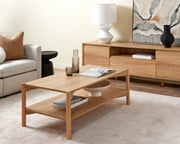
The perfect pairing: Entertainment Units and Living Room Furniture
Creating a harmonious and functional living room takes careful consideration. And at the heart of every living room is the entertainment unit. Serving as a functional necessity as well as a defining focal point that can shape your living room's overall ambiance. Learn the art of pairing your existing living room furniture with the right entertainment unit style, to create a cohesive space.The Central Role of Entertainment Units Entertainment units often act as the focal point in our living rooms, which makes it a great first piece to consider when setting-up your living room layout. These units are more than functional; they are versatile pieces that house electronics and provide storage while contributing to the room's aesthetic. The style of your entertainment unit significantly influences the room's overall atmosphere. Tip: Consider your living room's size when selecting an entertainment unit. Smaller spaces benefit from compact units, while larger rooms can accommodate substantial units as a central focus. To ensure a perfect fit, use provided dimensions and create a tape outline of where you want the unit. This visual guide allows for efficient experimentation with unit placement and room layout. Understanding Living Room Dynamics To harmoniously pair your entertainment unit with other furniture, it's essential to have spatial awareness. Consider your living room's layout, traffic flow, and furniture placement for optimal space utilisation. Striking a balance between function and aesthetics is key for a practical yet visually pleasing living room. Coordinating with Seating Furniture Position your couches and chairs for primary viewing around your entertainment unit. This will help coordinate your other living room furniture. Ensure they align with the unit's style and location, providing comfortable viewing and contributing to the room's aesthetics. Matching the styles of both your entertainment unit and seating arrangements is paramount. Tip: If you already have existing furniture in your living room, look for entertainment units that harmonize with your current aesthetic and colour palette. This approach ensures seamless integration, promoting visual consistency and an appealing look.Creating Harmonious Spaces: Storage, Décor, and Accents To curate a cohesive living room, integrate your storage and shelving choices with your decor and accent pieces. Opt for storage solutions that align with your entertainment unit's style, incorporating open shelving for creative displays. Utilise the "pairs of three" rule and vary item heights for visual interest while maintaining simplicity. Avoid overcrowding shelves for a clean, uncluttered atmosphere. Consider integrating ottomans, stylish baskets, or cube storage for efficient organization that aligns with your aesthetic. Integrating Lighting Solutions Set the mood in your living room with the help of lighting, making a significant difference in how you perceive the space. Adequate general lighting creates a welcoming atmosphere and enhances the role of your entertainment unit as a focal point. Ensure specific areas, such as reading or workspaces, have sufficient task lighting.Practical Tips and Common Mistakes to Avoid Proportional Balance: To maintain an aesthetically pleasing and organized living room, ensure that furniture pieces are proportionally balanced. Experiment with different furniture arrangements to optimize the use of your space and draw attention to your entertainment unit without overwhelming the room. Declutter Strategically: Strategically organize your living room to prevent a cluttered appearance. Use ottomans, stylish baskets, or cube storage as functional solutions to keep your space tidy. Experiment with different storage options and placements to maintain a clean and uncluttered atmosphere while making the most of your room's natural light. Comfortable Pathways: When experimenting with room layout, pay attention to walkways and windows. Ensure that your furniture arrangement doesn't block natural light sources and leave clear pathways for easy navigation. Position your seating furniture to maximize the flow of natural light into your living room, creating an inviting and well-lit atmosphere. In conclusion, when pairing entertainment units with other living room furniture, consider the following factors; dynamics of your space, functionality and overall aesthetic your looking to achieve. By paying attention to these aspects and drawing inspiration from real-life examples, you can transform your living room into a space that truly reflects your style and personality, making it a place where you can relax, entertain, and create lasting memories.


